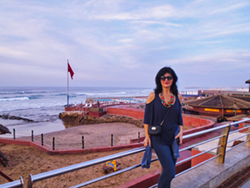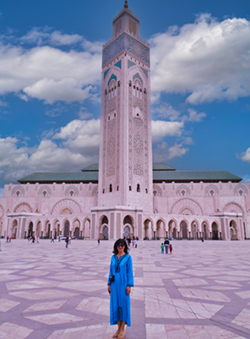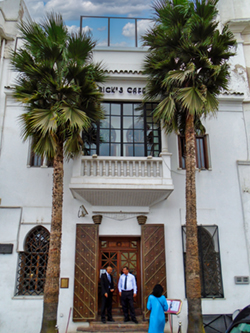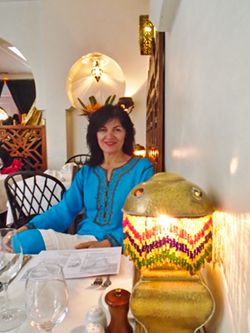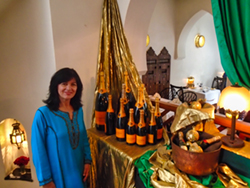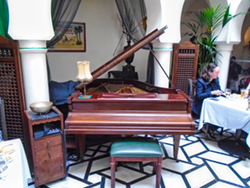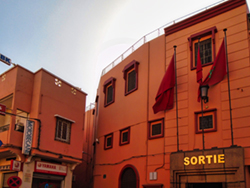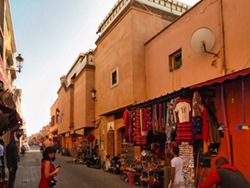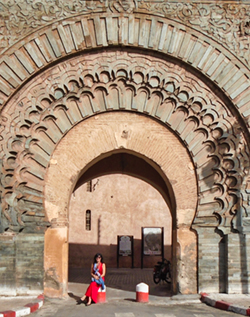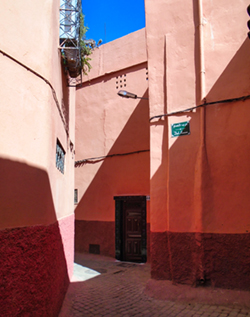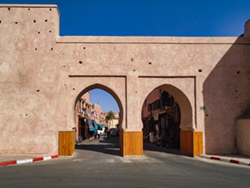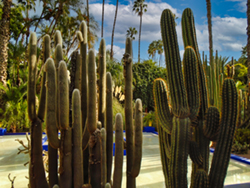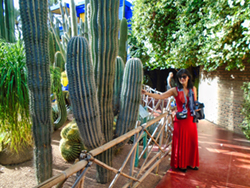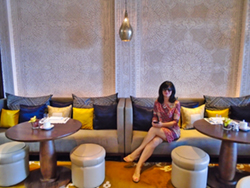

Morocco, from coast to desert
Memories from Casablanca and Marrakesh
Facts about Morocco
Morocco is a northwest African country perfectly located and surrounded by Atlantic Ocean on the west and enjoys all beauty and calmness of Mediterranean Sea on the north side.
Such location, throughout the history, had created Berber, Arabian and European cultural influences to Morocco. The official language is Arabic; however French language is equally important and spoken among people.
Capital: Rabat
Currency: Moroccan dirham
King: Mohammed VI of Morocco
Population: roughly 37 million
Official languages: Arabic and Berber
Climate:In terms of area, Morocco is comprised predominantly of "hot summer Mediterranean climate" (Csa) and "hot desert climate" (BWh) zones.

Imperial cities
Rabat, Marrakesh, Fez and Meknes are Morocco’s four imperial cities and visitors can enjoy getting lost amid their maze-like medinas, which have been made UNESCO World Heritage Sites.
Ancient cities, modern metropolises, gorgeous coastal resorts, and remote towns on the edge of the desert makes Morocco the exotic country on Europe’s doorstep.
Fez is a northeastern Moroccan city often referred to as the country’s cultural capital. It’s primarily known for its Fes El Bali walled medina, with medieval Marinid architecture, vibrant souks and old-world atmosphere.
Rabat as Morocco’s capital, is home to the country’s most important museum, the Royal Palace, and the Mausoleum of Mohammed V, as well as several historical tourist attractions.
Meknes was the capital city for the Alaouite dynasty (17th century). Its Sultan Moulay Ismaïl redesigned the city in Hispano-Moorish style. Meknes is enclosed by 25 km long walls that are pierced by monumental gates like the Bab Mansour.
Marrakesh is home to mosques, palaces and gardens.
Since the independence of Morocco, Marrakesh has thrived as a tourist destination. In the 1960s and early 1970s the city became a trendy "hippie mecca". It attracted numerous western rock stars and musicians, artists, film directors and actors, models, and fashion divas,
Casablanca with city’s French colonial legacy is port city and commercial hub in Marocco...
Culture
Morocco is a country with a rich culture and civilisation. Through Moroccan history, it has hosted many people coming from East (Phoenicians, Jews and Arabs), South (Sub-Saharan Africans) and North (Romans, Andalusians). All those civilisations have affected the social structure of Morocco.
Since independence, a veritable blossoming has taken place in painting and sculpture, popular music, amateur theatre, and filmmaking. The Moroccan National Theatre (founded 1956) offers regular productions of Moroccan and French dramatic works. Art and music festivals take place throughout the country during the summer months, among them the World Sacred Music Festival at Fes.
Each region possesses its own specificities, thus contributing to the national culture and to the legacy of civilization. Morocco has set among its top priorities the protection of its diverse legacy and the preservation of its cultural heritage.
Culturally speaking, Morocco has always been successful in combining its Berber, Jewish and Arabic cultural heritage with external influences such as the French and the Spanish and, during the last decades, the Anglo-American lifestyles.
Memories from Casablanca
Casablanca is a port city and commercial hub in western Morocco, fronting the Atlantic Ocean. The city’s French colonial legacy is seen in its downtown Mauresque architecture, a blend of Moorish style and European art deco. Standing partly over the water, the enormous Hassan II Mosque, completed in 1993, has a 210m minaret topped with lasers directed toward Mecca.
Modern, vibrant and festive, Casablanca is the economic capital of Morocco. Its dynamism, Art Deco architecture and mild climate make it a favourite destination. It runs along the coast, with its magnificent private and public beaches, and trendy restaurants and bars in full sun.
Alcohol is served in licensed hotels, bars and in tourist areas. However, drinking alcohol in the street and anywhere other than a licensed restaurant or bar isn’t allowed and can lead to arrest.
The Hassan II Mosque is the largest functioning mosque in Africa and is the 7th largest in the world. Its minaret is the world’s second tallest minaret at 210 metres. Completed in 1993, it was designed by Michel Pinseau under the guidance of King Hassan II and built by Moroccan artisans from all over the kingdom. The minaret is 60 stories high topped by a laser, the light from which is directed towards Mecca. The mosque stands on a promontory looking out to the Atlantic Ocean; worshippers can pray over the sea but there is no glass floor looking into the sea. The walls are of hand-crafted marble and the roof is retractable. A maximum of 105,000 worshippers can gather together for prayer: 25,000 inside the mosque hall and another 80,000 on the mosque’s outside ground. This stately mosque, a fine example of pure Moroccan architecture, is the only one in the city that non-Muslims may visit. As my wife had bought their typical dress as an suvenir, we didn’t have any problem to visit it. Furthermore, for a small amount of money we had a guide who took us to a different places of this building. Here are some of our recordings...




Legendary Rick’s Café Américain is the place designed to recreate the bar made famous by Humphrey Bogart and Ingrid Bergman in the movie classic “Casablanca“. It was 1942, the world was at war, and the eponymous city was occupied by the Axis powers. Rick’s was just the figment of a writer’s imagination. It never existed, except on a Hollywood movie lot, where the classic film starring Humphrey Bogart and Ingrid Bergman was made. The owner and founder of the real Rick’s Café in Casablanca is a former American diplomat, Kathy Kriger (1946 - 2018). Since opened on March 1, 2004, her Rick’s Café seems a success, filling its tables in five dining rooms over two floors for lunch and dinner on most days. At any given sitting there are guests from such a variety of places they would rival the movie’s own very international set of characters, and cast. The incarnation of Rick’s Café has nothing to do with World War II, but a lot to do with the modern-day war on terrorism, and Ms. Kriger’s own small role in it. It also has much to say about the enduring power of a great work of art to affect destinies in real life. Not coincidentally, Ms. Kriger on most nights could be found standing at the corner of the bar, the waiters under instructions to refill her wine glass with water until 11 p.m., when a Moroccan Val d’Argan Blanc is allowed. A lot of the regulars call her ”Madame Rick.” The restaurant is housed in a traditional Moroccan grand mansion with a central courtyard (riad), built in 1930. Two palm trees flank its front door, and the land placement allows for three facades: a distinctive streetfront entrance with heavy wooden doors that depict that of the film; a port-oriented façade that looks to the Atlantic; and a narrow dead-end access which was the former main entrance but is now the service entrance.
Memories from Marrakesh
Marrakesh, a former imperial city in western Morocco, is a major economic center and home to mosques, palaces and gardens. The medina is a densely packed, walled medieval city dating to the Berber Empire, with mazelike alleys where thriving souks (marketplaces) sell traditional textiles, pottery and jewelry. A symbol of the city, and visible for miles, is the Moorish minaret of 12th-century Koutoubia Mosque.

On the second day of our stay in Casablanca, we decided to take a side trip to Marrakesh. It takes about 3 hours by train each way, so we booked first-class tickets for an early morning train. It is important to remember the train station name you’re leaving from, just to make sure that on the way back, you will get off the train at the same place. The cabin was filled with 6 of us: 2 from Croatia, a doctor from Morocco, a young Moroccan businessman but working in Qatar, 1 volleyball coach from Sweden with the Moroccan lady who was his Arabic interpreter. We were really, a small United Nation team exchanging their own experiences so, those 3 hours up to Marrakesh passed really fast. It was a fun train ride. As it was just a day trip, and the latest afternoon train back to Casablanca was scheduled around 5:30 pm, we really didn’t have a lot of time to waste. Straight from the train station, we took a taxi to the Marrakesh center where our tour started. There was no hop-on-hop-off bus, therefore the carriage with 2 horses was good enough, actually a great experience. The carriage driver took us to the most important places in this short period of time. Let our camera continue talking.......
The Majorelle Garden is a one-hectare botanical garden and artist’s landscape garden in Marrakech, Morocco. It was created by the French Orientalist artist Jacques Majorelle over almost forty years, starting in 1923, and features a Cubist villa designed by the French architect, Paul Sinoir in the 1930s. The gardens are a major tourist drawcard in Marrakech, attracting more than 700,000 visitors annually. The garden hosts more than 15 bird species that are endemic to North Africa. It has many fountains, and a notable collection of cacti. Visiting Le Jardin Majorelle in Marrakech is one of the best things to do in Marrakech. Le Jardin Majorelle is also known as the Majorelle Garden or the Yves Saint Laurent (YSL) garden. This enchanting attraction is iconic nowadays, and is most definitely one of the most visited spots in the Marrakech.
